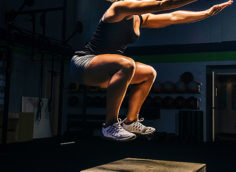A "double under" is a form of rope skipping in which the rope passes under your feet twice for every one jump. They can be tossed in sporadically while rope skipping or strung together for many double unders in a row. Done correctly, they'll help you torch calories, sculpt calves, improve endurance, and boost overall athleticism. It's intense, it's fun, and it's highly rewarding.
Problem is, becoming proficient enough to get the benefits takes time, practice, and whip marks! Continually doing sloppy double unders will make it hard for you to get good at them. To get better faster, avoid these five common double-under errors.
1 – The Slow-Moving Rope Error
Trying to transition from the single jump into double unders with a slow-moving rope will make you trip. Many beginners try to get their double unders going by first starting with a few single-under skips and then transitioning into doubles. This is fine, unless they're doing their single-under skips with a slow-turning rope.
Your rope needs to be moving fast in order for it to pass twice under your feet... unless you can levitate. Attempting to transition into double unders from a rope that's turning slowly leaves too much contrast in speed to overcome. Think about traveling in a car. It's more efficient to accelerate up to 60 mph if you're already going 45 mph than it is to accelerate to 60 if you're only going 15.
The Fix
Before attempting your first double under, make sure you get comfortable with single-under skipping at a fast pace. Practice adding velocity with every turn of the rope, even if it doesn't seem necessary. Doing this ensures you're fully in control of the rope. Many beginners allow the rope to turn on its own once they get it started. This will eventually set the rope and foot speed out of sync (the rope is influenced by the friction of the ground). Set the pace of the rope – don't allow the rope to set your pace.
2 – The High-Jump Error
Most people will overestimate how high they need to jump. The thought of needing to pass the rope under the feet two times while you're in the air makes this an easy mistake to make. But the difference in jump height for a double under versus a single-under isn't as much as you think... if you're efficient.
Jumping too high wastes energy, creates more landing force that'll need to be absorbed, and disrupts the timing and coordination of rope speed to foot/jump speed.
The Fix
This really goes back to rope speed. A rope that turns slowly will require you to create more hang time (jump higher) to give the rope enough time to come through twice. If you have the rope going faster, you can afford to take a shallower, more efficient jump. The challenge is to learn the precise jump height – not too high, not too low. This will keep the rope in sync with your jumps, and ration your energy for longer periods of time.
3 – The Donkey-Kick Error
The tendency to bend the knees while in mid-air is a result of one of two things: You think you need to lift your feet out of the way of the rope to keep from tripping it up. Or you lack lower body explosiveness, especially in the calves.
Bending the knees makes rebounding immediately into another jump very difficult. This will disrupt timing and create unnecessary impact with the ground, which will apply extra stress to nearly all tissues of the body.
The Fix
Try to generate the majority of the jumping effort through the calves. This will eliminate the need for your knees to bend and clear the rope. If this doesn't work, build explosiveness in your legs by training heavy squats and deadlifts, cleans, snatches, box jumps, and other plyometrics.
4 – The Violent-Arm Error
Don't rely on your arms to turn the rope. You may get away with this for a basic single-under skip, but if that technique is all you know you'll quickly realize that it's an error in form once you graduate to doing doubles.
Using the arms to turn the rope will fatigue your shoulders and arms quickly. It'll be challenging to keep the rope going any longer than 30 seconds if you rely on your arms to do the work. Most importantly, moving your arms through the range of motion required to turn the rope will be way too slow. And violently whipping your arms all over the place could lead to a variety of upper body issues.
The Fix
Turn the rope using the wrists. It's really that simple.
5 – The Spread-Arm Error
Feeling the need to keep your arms away from your body is an indication that you have poor shoulder mobility (you lack the ability to externally rotate the humeri, to be specific). When holding a jump rope, the closer your arms are to your side, the more you'll need to externally rotate at the shoulder to keep the handles away from your body. Therefore, the opposite is true. The wider your arms, the less external rotation is needed to hold a jump rope.
Arms held out will inevitably fatigue the shoulders. It also makes the rope shorter, giving you less margin for error as the rope passes under your feet. With fatigued shoulders and a shorter rope length, it'll become more and more challenging to manage uniformity in your skipping. Uniform rope length, jump height, timing, etc. is essential to successful skipping.
The Fix
Keep your arms fairly tight to your sides. If your shoulders are stiff, it'll feel uncomfortable to do this. Aside from simply being cognizant of keeping your arms closer to your body, be mindful of your posture throughout the day and stretch the humeral internal rotators (the shoulder muscles that help rotate the arm) until you can externally rotate your shoulders with more ease.





